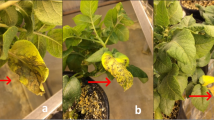Summary
Calluses of spring and winter wheats (Triticum aestivum L.) were selected for Fusarium resistance in vitro, using the double-layer culture technique. Potato-dextrose agar medium in vials was inoculated with mycelia of Fusarium graminearum and F. culmorum. After one week, fungal cells were killed by autoclaving and the agar medium containing the thermostable toxic metabolites was overlayered with MS callus-growing medium. Later, wheat calluses were placed on the upper medium for 4–5 weeks, and from the surviving calluses plants were regenerated. R2 seedling populations from self-fertilized R1 plants of 4 varieties were tested for Fusarium resistance by artificial infections in the greenhouse, and 3% of the regenerated R2 plants have been found to be more resistant than the original cultivars.
Similar content being viewed by others
References
Arcioni, S., M., Pezzotti & F., Damiani, 1987. In vitro selection of alfalfa plants resistant to Fusarium oxysporum f.sp. medicaginis. Theor. Appl. Genet. 74: 700–705.
Atanasoff, D., 1920. Fusarium blight (scab) of wheat and other cereals. J. Agric. Res. 20: 1–32.
Austwick, P.K.C., 1984. Fusarium infections in man and animals In: M.O., Moss & J.E., Smith (Eds.), The applied mycology of Fusarium, pp. 127–140, Cambridge Univ. Press, Cambridge.
Bartók, T. & F., Sági, 1990. A new, endosperm-supported callus induction method for wheat (Triticum aestivum L.). Plant Cell, Tissue and Organ Cult. 22: 37–41.
Binarová, P., J., Nedelnik, M., Fellner & B., Nedbálková, 1990. Selection for resistance to filtrates of Fusarium spp. in embryogenic cell suspension culture of Medicago sativa L. Plant Cell, Tissue and Organ Cult. 22: 191–196.
Chawla, H.S. & G., Wenzel, 1987. In vitro selection of barley and wheat for resistance against Helminthosporium sativum. Theor. Appl. Genet. 74: 841–845.
Daub, E.M. 1984. A cell culture approach for the development of disease resistance: Studies on the phytotoxin cercosporin. Hort. Sci. 19: 18–23.
Daub, E.M. 1986. Tissue culture and the selection of resistance to pathogens. Ann. Rev. Phytopathol. 24: 159–186.
Gocho, H. 1985. Wheat breeding for scab resistance. Wheat Information Serv. No. 60: 41.
Hartman, C.L., T.J., McCoy & T.R., Knous, 1984. Selection of alfalfa (Medicago sativa) cell lines and regeneration of plants resistant to the toxin(s) produced by Fusarium oxysporum f.sp. medicaginis. Plant Sci. Lett. 34: 183–194.
Joffe, A.Z.. 1974. Toxicity of Fusarium poae and F. sporotrichoides and its relation to alimentary toxic aleukia. In: I.F.H., Purchase (Ed.), Mycotoxins, pp. 229–262. Elsevier, Amsterdam.
Kaleikau, E.K., R.G., Sears & B.S., Gill, 1989. Control of tissue culture response in wheat (Triticum aestivum L.). Theor. Appl. Genet. 78: 783–787.
Latunde-Dada, A.O. & J.A., Lucas, 1988. Somaclonal variation and resistance to Verticillium wilt in lucerne, Medicago sativa L., plants regenerated from callus. Plant Sci. 58: 111–119.
Lepoivre, P., J., Viseur, K., Duhem & N., Carels, 1986. Doublelayer culture technique as a tool for selection of calluses resistant to toxic material from plant pathogenic fungi. In: J., Semal (Ed.). Somaclonal variations and crop improvement, pp. 45–52. Nijhoff, Dordrecht.
Maddock, S. & J.T., Semple, 1986. Field assessment of somaclonal variation in wheat. J. Exper. Bot. 37: 1065–1078.
Mégnégneau, B. & M., Branchard, 1988. Toxicity of fusaric acid observed on callus cultures of various Cucumis melo genotypes. Plant Physiol. Biochem 26: 585–588.
Mesterházy, A. 1978. Comparative analysis of artificial inoculation methods with Fusarium spp. on winter wheat variaties. Phytopath. Z. 93: 12–25.
Mesterházy, A. 1989. Progress in breeding wheat and corn genotypes not susceptible to infection by Fusarium. In: J., Chetkowski (Ed.), Fusarium mycotoxins, taxonomy and pathogenicity, pp. 357–386. Elsevier, Amsterdam.
Mielke, H. 1988. Untersuchungen über Fusarium culmorum (W.G.Sm.) Sacc. als Fuss- und Ährenkrankheitserreger beim Weizen. Mitt. Biol. Bundesanst. f. Land- u. Forstwirtschaft, Berlin-Dahlem, Heft 238.
Murashige, T. & F., Skoog, 1962. A revised medium for rapid growth and bioassay with tobacco tissue culture. Physiol. Plant. 15: 473–497.
Patey, A.L. & J., Gilbert, 1989. Fate of Fusarium mycotoxins in cereals during food processing and methods for their detoxification. In: J., Chetkowski (Ed.): Fusarium mycotoxins, taxonomy and pathogenicity, pp. 399–420. Elsevier, Amsterdam.
Pauly, M.H., W.W., Shane & B.G., Gengenbach, 1987. Selection for bacterial blight phytotoxin resistance in wheat tissue culture. Crop Sci. 27: 340–344.
Rengel, Z. 1987. Factors involved in initiation of somatic embryogenesis in cereal tissue culture. Acta Bot. Croat. 46: 33–43.
Snijders, C.H.A. 1987. Interactions between winter wheat genotypes and isolates of Fusarium culmorum Med. Fac. Landbouww. Rijksuniv. Gent, 52 (3a): 807–814.
Snijders, C.H.A., 1990. Genetic variation for resistance to Fusarium head blight in bread wheat. Euphytica 50: 171–179.
Toyoda, H., K., Shimizu, K., Chatani N., Kita, Y., Matsuda & S., Ouchi, 1989. Selection of bacterial wilt-resistant tomato through tissue culture. Plant Cell Rep. 8: 317–320.
Wang, Y.Z. & J.D., Miller, 1988. Effects of Fusarium graminearum metabolites on wheat tissue in relation to Fusarium head blight resistance. J. Phytopathol. 122: 118–125.
Wenzel, G. 1985. Strategies in unconventional breeding for disease resistance. Ann. Rev. Phytopathol. 23: 149–172.
Wenzel, G. & B., Foroughi-Wehr, 1990. Progeny tests of barley, wheat, and potato regenerated from cell cultures after in vitro selection for disease resistance. Theor. Appl. Genet. 80: 359–365.
Yu, Y.J. 1982. Monosomic analysis for scab resistance and yield components in the wheat cultivar Soo-moo-3. Cereal Res. Comm. 10: 185–189.
Author information
Authors and Affiliations
Rights and permissions
About this article
Cite this article
Ahmed, K.Z., Mesterházy, Á. & Sági, F. In vitro techniques for selecting wheat (Triticum aestivum L.) for Fusarium-resistance. I. Double-layer culture technique. Euphytica 57, 251–257 (1991). https://doi.org/10.1007/BF00039671
Received:
Accepted:
Issue Date:
DOI: https://doi.org/10.1007/BF00039671




